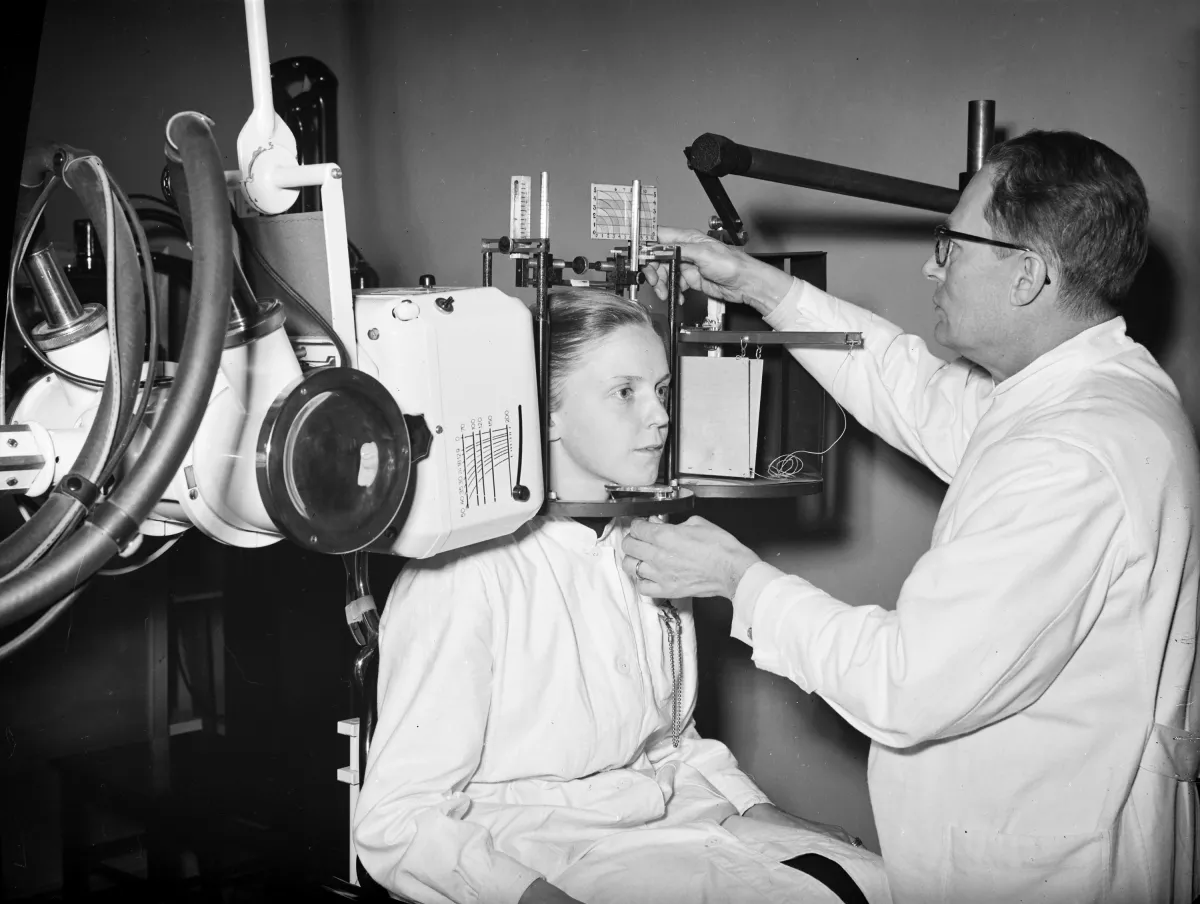
The First Orthopantomograph and its Inventor
Throughout history, people have been captivated by stories of revolutionary inventions and their inventors, like Bell's telephone, Fleming's penicillin, or Roentgen's X-ray. To this group of brilliant inventors surely belongs the genial Yrjö V. Paatero. A renowned Doctor of Dentistry, who, in 1946, created the groundbreaking machine, the Orthopantomograph. His invention has since changed the field of dentistry.
Dental panoramic X-ray imaging – a Finnish invention
Doctor of Dentistry Yrjö V. Paatero worked at the Department of Dentistry of the University of Helsinki, where he, after the War, was responsible for X-ray examinations and diagnostics. There was not enough time for the research work that Paatero longed for as the days were filled with routine work. X-ray film was placed inside the patient's mouth again and again, as several X-rays had to be taken to determine the condition of the entire dentition. “There must be a faster solution to this” Paatero said, and the seed of panoramic X-ray imaging had sprouted. However, the road to this was not simple.

A long road to becoming an academic researcher
Yrjö Veli Paatero was born in 1901 in Helsinki. He first studied metalwork in a vocational school for boys, and then completed secondary school while working in a warehouse and graduated from the evening course of Finnish Private High School in 1933, when he was 32 years old. At the same time, he started studying dentistry, still alongside work, and graduated with a bachelor's degree in three years.
The researcher's career began at the age of 36 at the Department of Anatomy of the University of Helsinki. Paatero's first scientific article, done in cooperation with Esko Näätänen, on X-ray examinations of the frontal sinuses, was published in 1938. His dissertation was on the same topic and was reviewed the following year, while his dental studies were still in progress. He graduated as a licentiate in 1941 and received his doctorate in the same year. The war interrupted his research career for several years, and Paatero directed his energy and organizational skills to starting and managing the operations of the Blood Service of the Finnish Defense Forces.
Preforms of the panoramic X-ray device
Paatero named his first X-ray imaging method, completed in 1949, Parablography. In it, a strip-like film was placed in the patient's mouth, and by rotating the patient's chair, the entire dentition was covered with the film at once. He developed this idea further and in 1950 a Pantomograph, where the film was bent in front of the patient's face, was done. This was a sensation in the development of imaging methods, as the technique made it possible to obtain curved layered images of any part of the body.
Paatero saw still room for improvement in this technology and developed a test version of the next stage of the invention, the Orthopantomograph. The device was built from parts found in Paatero's toolbox and had two round plates side-by-side that rotated by turning a lever. When using the experimental model, an X-ray film bent into the shape of the letter U is placed on top of the plate shown in the picture on the right. On top of the plate on the left is a stand built from a small cardboard box, on which the skull was placed for test imaging. A working prototype was built in 1957 and with it, the first panoramic X-ray image of a skull was taken where every tooth was recorded on the film perpendicularly. In the final version, the patient’s chair stayed still and the film and X-ray machine were moving instead.

A race to utilize the invention
Yrjö V. Paatero financed his work for inventing panoramic x-ray imaging mostly by himself as a grant was not offered to him in Finland. The decisive point was when Paatero was invited to the University of Washington in the United States in 1950 to develop his then-invented parablography, based on the articles he wrote on the subject. He worked in the United States for 1.5 years almost day and night, not wanting to waste a single moment of the time he had all the material resources at his disposal. In September 1951, his stint in the United States ended and as he was leaving, he noticed that all the papers related to the development of the pantomograph had disappeared from his briefcase.
After arriving to Finland, he made new paperwork, plans and drawings of the pantomograph from memory, and the construction of the device was financed by the Department of Dentistry of the University of Helsinki. In the United States, despite the drawings, plans and market potential, he failed to get the project financed, because one key factor was missing: a creative problem solver who could have solved the challenges associated with the idea. The new invention attracted others to benefit from it also. A cooperation to produce a pantomograph device in England called Rotagraph was formed, but that deal ended in bitterness right after the start of production. However, the world’s first pantomograph device, Orthopantomograph, was made in Finland and was born as a collaboration between Yrjö V. Paatero and Lääkintäsähkö Oy's technical director, Master of Science in Engineering Timo Nieminen.
A job well done will go on
Yrjö V. Paatero died suddenly in February 1963. However, in the last years of his life, he got to experience how the importance of his work was recognized in many ways. In 1954 and 1955, he was awarded first at the invention fair in Brussels, then in Paris. The President of Finland granted Paatero the title of professor in 1959. A professorship of dental radiology was established at the University of Turku and Paatero was invited to this position in 1961 due to his significant research. He also had time to get some financial benefit from his invention when the commercial production of the Orthopantomograph started in 1961 in Tuusula. The Factory is producing Orthopantomographs till today, under the new name Dexis.


